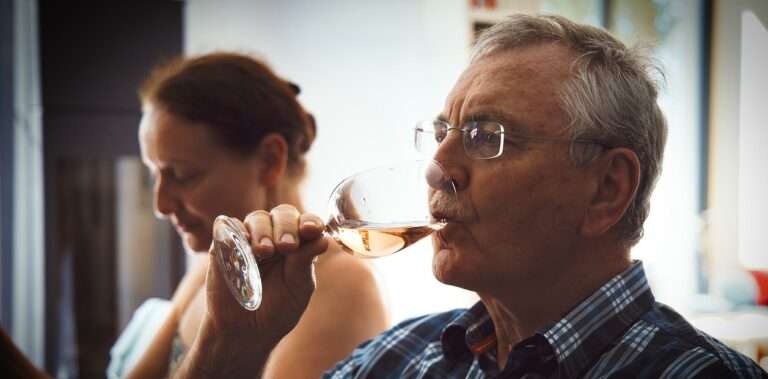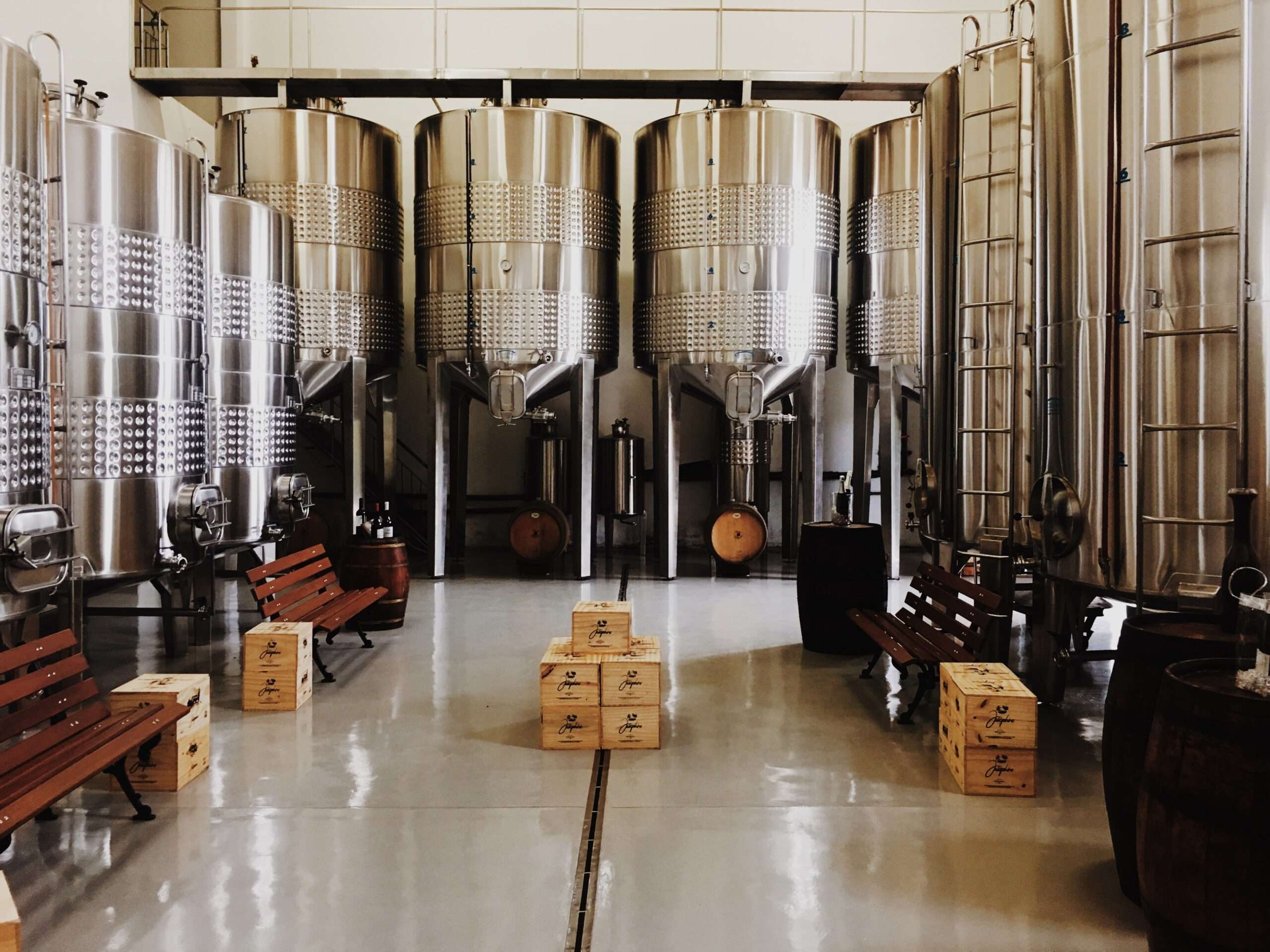If you’ve ever been out wine tasting and noticed that a few peers from your group had sniffed their wine before taking a sip, you may be wondering what wine smells like. Wine is gorgeously complex alcohol, with an assortment of different aroma profiles and subtleties lurking in every bottle.
Wine has three aromatic layers that give each bottle a unique and distinct smell. These layers are influenced by the variety of grapes, the fermentation process, and the aging of the wine. Common aromatic hints include florals, herbs, spices, and fruits.
If you would like to know why you should smell your wine, how to do it correctly, and how to accurately identify different aromatic hints within your wine, you’ve come to the right place!
Why Should You Smell Your Wine?
Although we’ve all probably seen wine tasters smell their wine before taking a sip, not many people know its reason.
Smelling wine is a way to detect the wine’s aromas and indicate how a wine will taste. You can quickly pick up most of a wine’s taste in its scent and reveal its flavor palette by learning how to smell a wine correctly.
Several factors can influence a wine’s flavor and smell. Because wine is made up of fermented grapes, yeast, and other select ingredients chosen by the winemaker, a wine’s taste can be pretty complex.
Almost every wine will smell differently, depending on how it is made and what ingredients were used in the fermentation and infusion process. This infusion makes for hundreds of exciting taste and smell combinations and various aromas in every bottle.
Of course, smelling a wine can also have other benefits. Smelling a wine also makes for more accurate pairings between wine and food. This is a particularly useful skill for sommeliers.
Being able to pick up on certain aromas and subtleties that the wine has will allow them to recommend certain wines to their clients, depending on their preferred taste.
You can also tell a full-bodied wine from a lighter wine just from its smell. You can also tell how the wine has aged and if it has gone bad.
But, before we get into the complexities of smelling wine, it is good to know how to smell your wine.
How To Properly Smell Wine
Smelling or sniffing wine requires a specific technique, so we’ve compiled a few essential tips and tricks to help you become a true wine connoisseur.
Firstly, you will need to use a decanter to pour your wine. You can also use an aerator to better allow your wine to oxidize and reduce any unfavorable flavors in your wine.
An aerator is a spout through which you pour your wine. At the same time, a decanter is a vessel that houses your wine and increases the wine’s surface exposure to let it properly air out before you taste it.
You can let a wine decant for up to three hours. However, you can wait for as little as an hour if time doesn’t allow it.
Once your wine has had time to decant, you can begin to pour it into your glass. Be sure to pour your wine at an angle. By doing this, you’ll allow the wine to be exposed to more oxygen which can help to enhance the flavor and eliminate any bitterness.
Next, you can begin to smell your wine. There is no right or wrong way to do this, as you can use any technique that best lets you evaluate the wine’s aroma and discern the different scents in your drink.
You can take short, decisive sniffs or gently inhale the scent deeply to get a better sense of the delicious smells – again, you should use a technique that works best for you! You can also take your time smelling your wine to get an even better idea of the drink’s flavor palate.
Lastly, you can begin to think about or describe the hints and subtleties of any aromas you may smell. Typically, the wine will have three distinct levels that you will be able to discern.
If you can’t tell the difference right away, you can take your time practicing. Smelling wine is a skill strengthened through practice, so there is no need to rush your experience.
Over time, you may notice that your descriptions become more accurate, and you can separate the aromatic layers more precisely.
The Three Aromatic Layers Of Wine
Now we can get to the fun part of smelling your wine: deciding how to describe the smell of your wine.
As we’ve mentioned, there are three distinct layers to your wine’s aroma, including the primary, secondary, and tertiary aromatic layers.
The primary aromatic layer will have aromas derived from the grape itself. These aromas are influenced by the variety of grapes used, the climate in which they are grown, and the wine’s aging process.
Typically, we refer to these aromas as primary aromas. They often have the smell of different fruits, herbs, and flowers.
The second aromatic layer is usually more intricate, and the secondary aromas will depend on the winemaker’s fermentation technique. How the winemaker made the wine, its storage, and how long it was stored or bottled will influence this.
These secondary aromas include more woody, earthy scents like nuts and cedar. Still, they can also be as delicate as lighter vanilla or floral scents.
When it comes to the tertiary aromatic layer, these aromas generally indicate the wine’s aging. Tertiary aromas are widely varied and include hints of spice, tobacco, vanilla, coffee, and even leather.
You may be able to discern tertiary aromas from the primary and secondary layers by smelling them as it wafts into the body of the glass after each sip. These aromas will have the lightest scent of all the layers.
Learning The Lingo
There are a few common words or phrases associated with the process when you smell a wine. By learning these, you can hone your skills and fit in with even the most discerning wine maestros!
The first thing to know is what to call the aroma of your wine. Typically, wine lovers will refer to the wine’s smell or aroma as the nose of the wine. So, when describing the notes you’re picking up on, you can talk about the wine’s nose.
Another common word associated with wine is its palate. This refers to the taste of your particular wine and is often paired with the phrase mouth feel or texture. These descriptors help articulate how the wine feels, ranging from smooth to sharp and full, medium, or light-bodied.
How To Smell A Full Vs. Light-Bodied Wine
Alcohol level, tannin, and acidity all affect how we perceive the body of the wine. The body of the wine may also be referred to as the texture or mouth-feel of the wine and is affected by the acidity, tannin, and alcohol levels of the wine.
When describing a wine as full-bodied, you usually refer to wine with low acidity levels but a higher alcohol and tannin level to it. These wines will usually feel fuller when sipped.
However, the notes will be stronger and richer when you smell a full-bodied wine. In white wines, it may have more notes of butter and a certain smoothness to its aroma.
Additionally, lighter-bodied wines will have low alcohol and tannin percentages but higher acidity levels. These wines will usually have a sharper, more crisp smell. The crispness may sometimes be likened to the smell of a green apple.
When you are smelling your wine, you can tell whether it will be a full or light body wine by assessing the different notes and overall aroma.
While it is mainly reserved for red wines, you can also get medium-bodied wines. These wines will have a more demure scent and will have a mix of smooth, rich aromas and sharp, crisp hints, depending on the winemaker’s blend.
Tips For Smelling Wine
Wine tasting and smelling should be a relaxing and enjoyable experience. But, when you’re learning how to smell your wine, there are a few different factors that can affect your experience.
If you’re planning on attending a wine tasting, you should try not to wear any strong or overpowering perfumes or scents. These can compete with the aroma of the wine, which will make it much more difficult to discern the aromatic layers of your drink.
Some wine tasting may be accompanied by a delectable lunch or a hearty dinner. Still, it would help if you were careful not to let the smell of your food interfere with your wine. Try and smell your wine before your food arrives to ensure that you are only picking up on the wine’s aroma.
It would be best if you also kept practicing your smelling skills in everyday life. By smelling ingredients when you cook or by trying to pick up on unique or unusual smells, you’ll better be able to train your nose to identify specific scents.
How To Smell Faults In Wine
Although there are tons of wine enthusiasts all over the globe, many of us are at fault for consuming wine that has been tainted by common faults. These faults can cause a wine to smell or taste differently from a high-quality wine. Still, even the most well-trained wine connoisseurs can fall prey to drinking a glass of faulted wine.
If you want to learn how to detect and sniff out these faults, you’ll need to have a keen eye and a sensitive nose. Luckily, we’ve got a simple guideline to help you pick up on some of the most common wine faults our favorite refreshments may have.
You should be able to pick up on specific faults just by looking at your wine. The color of your wine could tell you a lot about whether or not it is of high quality. If your wine is darker, the chances are that it is a slightly older wine. As with anything, the wine will change color over time.
If you’re struggling to decide whether your wine is more of a ruby red or darker maroon, you can give your wine a quick sniff. You may be able to smell the difference between a good wine and one that has been subjected to heat damage or cork taint.
Cork taint is a type of contaminant that resides in your wine bottle, and this fault is more often found in wines that have been kept in oak barrels. This fault will lead to a foul-smelling wine, which may be similar to mold, wet cardboard, or even a wet dog.
Corked wines will usually have a more muted flavor profile and tend to be quite bitter. In some instances, the wine itself may taste rotten and undrinkable. Luckily you won’t need to taste a corked wine to find its fault so that you can save your tastebuds a most unfavorable punishment!
Similarly, wines exposed to too much heat may also have a different nose than your regular wine. Heated wines will smell much sweeter and have the faint smell of cooked or reduced sugar.
When wine becomes too hot, the cork may push out and allow oxygen into the bottle. The continued exposure will alter the smell of your wine and the taste, too.
The most common reason wine goes bad is being left open for too long. So, if you’ve had an open bottle of wine sitting around for a while, it may be good to give it a sniff. If your wine has turned or gone bad, you may also notice that your wine smells extremely tart and overly nutty or earthy.
Conclusion
Wines can have many varied, complex aromas to them. The nose of the wine is often influenced by where the grapes were grown, the variety used, weather, fermentation, and even the bottling process.
Now that you know how to smell your wine correctly, you can practice until you’re ready to rub shoulders with even the most distinguished wine enthusiasts!















